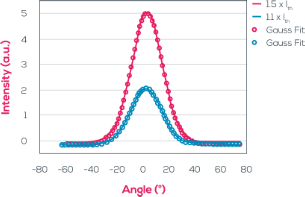|
QCL technology : Robustness and Reliability for semiconductor lasers
Quantum cascade lasers (QCLs) are intersubband semiconductor lasers emitting around a center wavelength ranging from the mid-infrared (4 – 12 µm) up to the terahertz domain. The QCLs proposed by mirSense are mid-infrared devices operating in pulsed or continuous-wave regime at room temperature. They can be either multimode (Fabry-Perot) or single-mode (Distributed FeedBack, or DFB) laser sources. QCLs from mirSense are based on a reliable and reproducible technological process, optimized through detailed simulations. They offer very high performances, typically a few hundreds of milliwatts in continuous-wave operation and up to a few tens of watts peak-power for pulsed mode. Furthermore they present high-quality beam profiles, with a low M2 in both directions.
Intersubbband lasers
As opposed to near-infrared laser diodes, where the lasing transition occurs between the conduction and the valence bands, the lasing transition in QCLs appears between two subbands within the conduction band. The wavelength is therefore not limited by the intrinsic energy gap of the material, and can reach values from the mid-infrared up to the terahertz range.
To improve the electrical to optical conversion efficiency, the structure of the laser is based on a cascade effect: each electron will cross typically 30 to 40 periods, and produce one photon at each stage.
High performance QCLs
QCLs from mirSense operate in continuous wave or in pulsed mode, with pulse durations typically from 50 ns up to 10 µs, at a repetition rate between 1 and 100 kHz. The thermal dissipation is optimized using COMSOL, in order to obtain thermo-electrically cooled QCLs, operating at temperature between 10° and 60°C.
These lasers are well-adapted for high-power operation since they can offer up to a few hundreds of milliwatts in continuous-wave operation and up to a few tens of watts peak-power for pulsed mode.
Multimode or single-mode operation
MirSense provides QCLs covering a large range of mid-infrared wavelengths from 3.8 to 9.8 µm, either in single-mode or multimode operations. Multimode (or Fabry-Perot) QCLs offer very high optical power, whereas single-mode (or Distributed FeedBack, DFB) lasers, and especially DFB QCL arrays, are well suited for spectroscopic applications.
The technique used to obtain DFB QCLs is unique and has been developed by mirSense. It is based on a top metal grating, allowing to avoid epitaxial regrowth and resulting in more than 30 dB side-mode suppression ratio.
High-quality beam profiles
Both near-field and far-field experiments give very high-quality beam profiles. The M2 of QCLs from mirSense is measured around 1.2 in both directions.
Optimized designs
Each new QCL structure is simulated and optimized before epitaxial growth by the use of a homemade software called METIS. It is based of semi classical Boltzmann-like equations using thermalized subbands, and takes into account optical and acoustic longitudinal phonons, roughness scattering, coherent tunneling through the barrier, absorption of photons, stimulated and spontaneous emission. Within this formalism, potential, energy states, wave functions as well as electronic scattering times between all the bound states can be retrieved, allowing the optimization of the design.
Mastered production
The epitaxial growth and technological process are then realized by experts, rending the technology reliable and reproducible.
|



